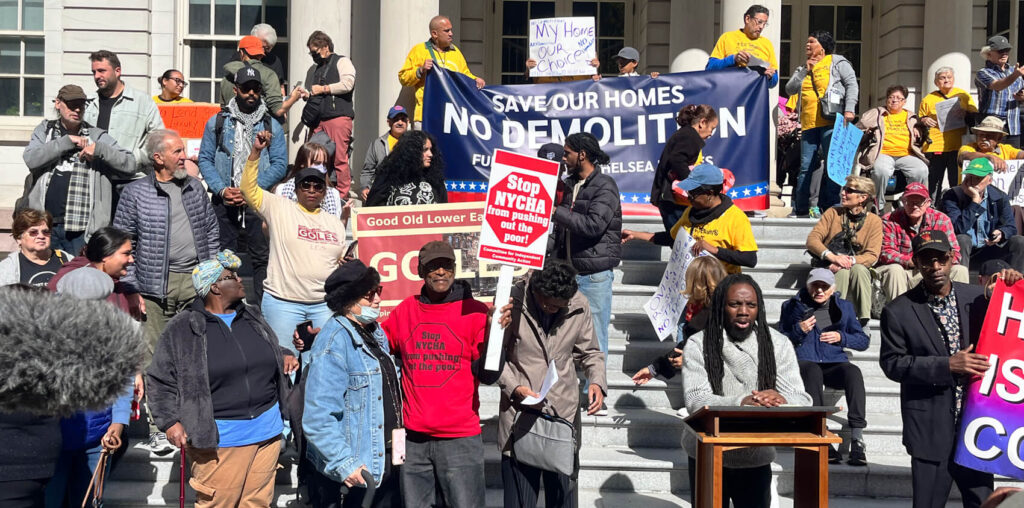Politicians, public housing residents, and tenants rights activists gathered on the steps of New York City Hall this week amid calls for Mayor Eric Adams’s resignation.
They were there on October 10 to protest the privatization and demolition of three NYCHA developments in the Manhattan neighborhood of Chelsea, Fulton Houses and Elliott-Chelsea Houses, where more than 5,000 people live in Section 9 public housing. The Fulton Elliott-Chelsea (FEC) plan is by Related, Essence, PAU, COOKFOX, and ILA, as reported by AN.
“I’ve been [in Fulton Houses] for 22 years, and this situation has made me beyond devastated,” said Jackie Lara, who staunchly opposes the FEC plan. “My home is being taken away from me. So the residents of our community firmly deny the proposed demolition of our homes which have multiple generations and families. I want my family to continue to be here.”
Lara added that she and other tenants have gathered 920 signatures (and counting) from Fulton and Elliott-Chelsea Houses residents who oppose the plan. That petition will soon be sent to NYCHA and city officials in order to stop the plan for Fulton and Elliott-Chelsea Houses from happening.
“Unbelievable Greed”
Members of Save Section 9 and Residents to Preserve Public Housing were present alongside Lara as well as Celines Miranda and Renee Keitt of Elliott-Chelsea Houses.
And so was Layla Law-Gisiko, who stepped down from Community Board 5 recently, and former Chelsea Reform Democratic Club president Luana Green, and a spokesperson for former New York City Councilor Charles Barron. In her speech, Keitt likened the FEC plan to “separate but equal,” a Jim Crow policy.

“We are being subjected to Related Companies and their unbelievable greed,” Keitt said into the microphone. “Carver, East River, Thomas Jefferson, Dewitt-Clinton, and Frederick Douglass Houses have already been exploited for profit by Related Companies. We are next in line. We are being sold out in the name of profit and our community is being decimated.” Keitt said too that politicians who support the FEC plan “should be ashamed of themselves,” namely Mayor Adams and Councilor Erik Bottcher, who represents Chelsea.
Marquis Jenkins, founder of Residents to Preserve Public Housing, affirmed that the protest was about much more than just buildings. “Today we fight not just for bricks and mortar,” Jenkins declared. “We fight for rights and protections. Residents who came before us fought for the 964 rules and regulations. Those rules and regulations guaranteed residents a seat at the table.”
The 964 rules and regulations Jenkins alluded to endows public housing residents the right to self-management, a right they would lose under PACT/RAD. Jenkins also accused NYCHA of “interfering with resident leadership” to push the FEC plan through.
“That is a Lie”
“NYCHA has not been absolutely honest with you,” echoed former New York City Councilor Charles Barron’s spokesperson, “because this should have been a tenant-led development. That has not been the case. We know that the majority of tenants have come out against this plan.” The spokesperson also railed against the environmental pollution the FEC plan would create when he lambasted the proposed destruction of 350 trees.
“We are not going to stand for this plan, because this plan is wrong,” Law-Gisiko said. “I’m sure you’ve heard that the city is pushing this narrative that increasing housing supply is the way we’re going to get out of the housing crisis. But that’s not true. You can’t build your way out of this crisis. The crisis is a crisis of affordability. And that’s why we need to keep housing affordable, and the gold standard of affordable housing is public housing.”

Law-Gisiko’s comments were in relation to City of Yes, Mayor Adams’s grand plan to add 500,000 new homes to New York in the next 10 years. Law-Gisiko continued that “public housing is the shield against displacement and gentrification.” She elaborated that tenants “have been deprived of the city and the federal government’s care” and the dire states of Fulton and Elliott-Chelsea Houses is NYCHA’s fault, not that of the residents.
“NYCHA’s claim that the only way to fix these buildings is with a wrecking ball is not acceptable,” Law-Gisiko said. “NYCHA and Related also say that these buildings are beyond repair. That is a lie. They also say that it’s cheaper to raise these buildings than repair them. That is also a lie.”
Last March, at Center for Architecture, those in favor of the FEC plan driving it forward presented the project to a room full of architects. Jamar Adams, founder of Essence Development; Jonathan Gouveia, NYCHA’s vice president of real estate development; Ruchika Modi, principal at PAU; and Manish Chadha, principal at Ismael Leyva Architects (ILA) were present.
Modi said that the proposed development would replace the current “towers in the park” at Fulton and Elliott-Chelsea Houses with perimeter block buildings that are more “integrated” into the neighborhood. Modi also said the development team would like to build a linear park between West 19th and 16th Streets as part of the project. After the gathering, Jamar Adams affirmed that the FEC plan is “resident led” and informed by “continued input from residents and the wider community.”
Looking ahead, given the hot water Mayor Adams now finds himself in, residents and tenants activists who oppose the plan see an opportunity to help stop it. “Only a handful of developers are allowed to participate [in PACT/RAD],” Jenkins added at the October 10 protest. “Are they giving the mayor kickbacks so that they can have access to public housing?”

